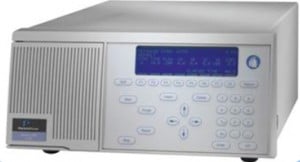“Optimism is the faith that leads to achievement, nothing can be done without hope and confidence”
—- Helen Keller
In the last module you appreciated the crucial role played by a detector in the HPLC system. In this module you will be introduced to the pump which provides continuous and consistent flow of mobile phase through the HPLC system. A pump can be compared to the human heart which continuously pumps blood throughout the body but though the human heart can withstand changes in blood pressure within specified limit due to stress and strain the HPLC pump is required to deliver flow of mobile phase at constant pressure and flow rate. Changes in both these parameters can lead to errors in the results. In simple language the HPLC pump has to have ruggedness and at the same time should be able to provide reproducible flow characteristics run after run. The operational pressure limits have a vast range depending upon analysis requirements. In normal analytical operation the pressure can vary between 2000 – 5000 psi but in applications covered under UHPLC mode operating pressure can be as high as 15000 – 18000 psi.
An ideal pump should have the following desirable characteristics
- Solvent compatibility and resistance to corrosion
- Constant flow delivery independent of back pressure
- Convenience of replacement of worn out parts
- Low dead volume for minimum problems on solvent changeover
Three commonly used pump types are Syringe type pumps, Constant pressure pumps and Reciprocating piston pumps.
Constant pressure pumps provide consistent continuous flow rate through the column with the use of pressure from a gas cylinder. Valving arrangement allows rapid refill of solvent chamber. A low pressure gas source is needed to generate high liquid pressures.
Syringe Type Pumps are suitable for small bore columns. Constant flow rate is delivered to column by a motorized screw arrangement. Solvent delivery rate is set by changing voltage on the motor. These pumps deliver pulseless flow independent of column backpressure and changes in viscosity but major disadvantages are limited solvent capacity and limitation on gradient operation
Reciprocating Piston pumps deliver solvent(s) through reciprocating motion of a piston in a hydraulic chamber. On the back stroke the solvent is sucked in and gets delivered to the column in the forward stroke. Flow rates can be set by adjusting piston displacement in each stroke. Dual and triple head pistons consist of identical piston chamber units which operate at 1800 or 1200 phase difference. The solvent delivery of reciprocating pump systems is smooth because while one pump is in filling cycle the other is in the delivery cycle. High pressure output is possible at constant flow rate and gradient operation is possible. However, pulse dampening is required for further elimination of pressure pulses.
We now have a fair understanding of different pumps and their operation principles and our next post will deal with injectors for injection of samples into the flowing mobile phase stream.
Tip of the day
After using buffers do not allow salts to dry as these can damage pump components. Always prime with water before shutting the system.
P.S
Did you get here from a link from a friend, or Twitter? This lesson is part 7 of 10 parts High Performance Liquid Chromatography Free e-course. To get more information about it and sign up Click here.


